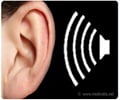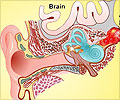Neurofeedback training has the potential to reduce the severity of tinnitus or even eliminate it, recent research using functional MRI (fMRI) found.
- Neurofeedback training may reduce the severity of tinnitus.
- It may also be able to eliminate tinnitus.
- Neurofeedback training helps tinnitus patients control brain reaction to stimulus.
For the study, researchers looked at a novel potential way to treat tinnitus by having people use neurofeedback training to turn their focus away from the sounds in their ears.
A control group of nine individuals were provided sham neurofeedback , they performed the same tasks as the other group, but the feedback came not from them but from a random participant. By performing the exact same procedures with both groups using either real or sham neurofeedback, the researchers were able to distinguish the effect of real neurofeedback on control of the primary auditory cortex.
Neurofeedback training plus functional MRI (fMRI)
The study represents the first time fMRI-neurofeedback training has been applied to demonstrate that there is a significant relationship between control of the primary auditory cortex and attentional processes. This is important to therapeutic development, Sherwood said, as the neural mechanisms of tinnitus are unknown but likely related to attention.
The results represent a promising avenue of research that could lead to improvements in other areas of health like pain management, according to Dr. Sherwood.
To determine the potential efficacy of this approach, the researchers had 18 healthy volunteers with normal hearing undergo five fMRI-neurofeedback training sessions. Study participants were given earplugs through which white noise could be introduced for periods of time. The earplugs also served to block out the scanner noise.
Tinnitus
Tinnitus is the perception of noise, often ringing, in the ear. The condition is very common, affecting approximately one in five people. As sufferers start to focus on it more, they become more frustrated and anxious, which in turn makes the noise seem worse. The primary auditory cortex, the part of the brain where auditory input is processed, has been implicated in tinnitus-related distress.
The participants then participated in the fMRI-neurofeedback training phase while inside the MRI scanner. They received white noise through their earplugs and were able to view the activity in their primary auditory cortex as a bar on a screen. Each fMRI-neurofeedback training run contained eight blocks separated into a 30-second "relax" period followed by a 30-second "lower" period. Participants were instructed to watch the bar during the relax period and actively attempt to lower it by decreasing primary auditory cortex activity during the lower phase.
The researchers gave the participants techniques to help them do this, such as trying to divert attention from sound to other sensations like touch and sight.
"Many focused on breathing because it gave them a feeling of control," Dr. Sherwood said. "By diverting their attention away from sound, the participants' auditory cortex activity went down, and the signal we were measuring also went down."
"Ultimately, we'd like take what we learned from MRI and develop a neurofeedback program that doesn't require MRI to use, such as an app or home-based therapy that could apply to tinnitus and other conditions," he said.
References:
- RSNA 2017 103rd Scientific Assembly and Annual Meeting - (http://www.rsna.org/)
Source-Eurekalert













